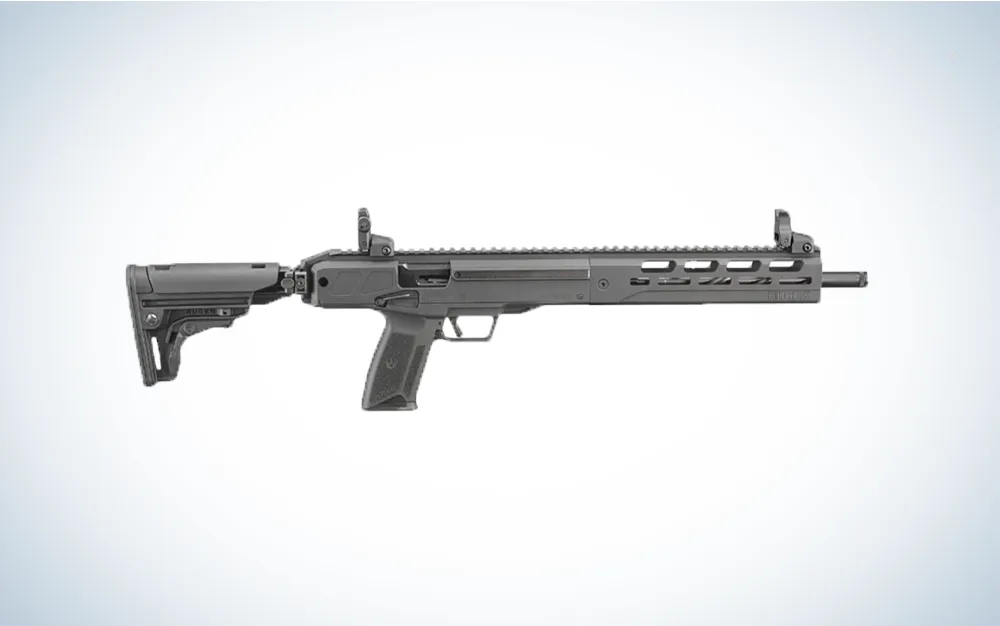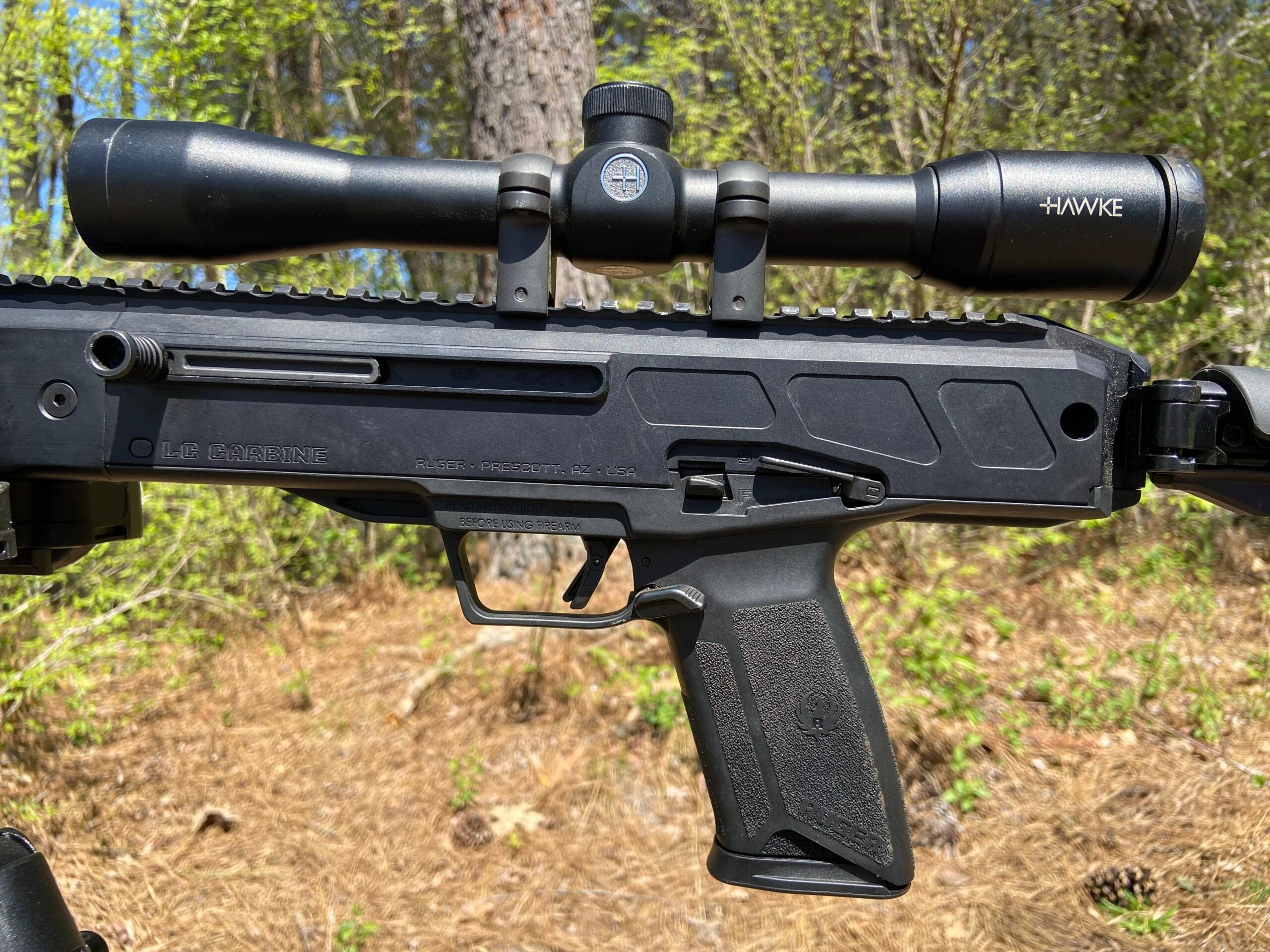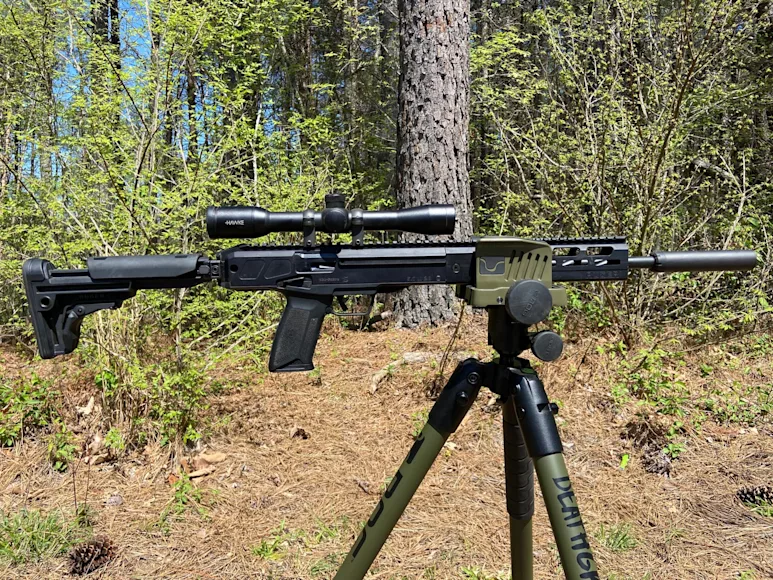_We may earn revenue from the products available on this page and participate in affiliate programs. Learn more ›
_
Maybe the Ruger LC Carbine
in 5.7x28mm wasn’t designed for hunting wild pigs in a wheat field, but that’s how I used it just the other day. We’d been chasing gobblers that morning and were headed to the truck to reposition on a henned-up bird. That’s when I spotted the hogs—two sows and a dozen 20-pound shoats—rooting at the edge of the field 300 yards away. I’m not sure you could’ve scripted a more perfect scenario for needing a truck gun.
I quietly traded my shotgun for the carbine in my truck and, with a good breeze in my face, slipped down the treeline to within 96 yards of the pigs. I rested the carbine against a T-post and dropped the biggest sow in her tracks with a single, 40-grain V-Max bullet. Since the rifle was suppressed, the report was about like a .22 Short—quiet enough, in other words, to kill the pig, put some pork in the cooler, and be back on the same gobbler 30 minutes later.
Ruger LC Carbine Review Table of Contents
5.7x28mm Overview
Ruger Adds 5.7x28mm Guns to Their Lineup
5.7x28mm Ammo Options
Testing the LC Carbine
What is the 5.7x28mm Good For?

5.7x28mm Overview
The 5.7x28mm was designed for military use. As the story goes, it was introduced by Fabrique Nationale (FN) Herstal in the early 2000s, at the request of NATO, to be a replacement cartridge for the 9x19mm. It was officially standardized by NATO in 2021. The 5.7 is a centerfire, bottlenecked cartridge with no parent case. It fires a .22-caliber bullet, and the overall cartridge length is about 1.6 inches. Its case is both longer and of larger diameter than the rimfire .22 WMR, to which it’s often compared. The 5.7 was designed for both handgun and Personal Defense Weapon (PDW) use, and it is in service in some form in more than 40 countries around the world, including with the U.S. Secret Service here at home.
Civilian interest in the cartridge has been sluggish until recently, partly by design. FN restricted sales of many of its cartridges to military and law enforcement. Few other companies sold factory loads. Guns were scarce, too. For years, the FN Five-seveN pistol was about the only firearm a civilian could get chambered in 5.7x28mm. The FNP90 submachine gun was also limited, of course, to military and law enforcement sales (though the semi-auto PS90 is now available for civilian purchase). There were some AR builds in 5.7, but they weren’t something you were likely to see on the rack at your local gun shop.
Ruger Adds 5.7x28mm Guns to Their Lineup
Ruger changed a lot of that with the introduction of their 5.7 pistol in 2019. I tried one at the SHOT Show Range Day that year—my first experience with the cartridge—and was impressed with how easy and fun it was to shoot. Defensive potential aside, a standard-sized polymer handgun that holds 20 rounds of flat-shooting V-Maxes is pretty appealing as an outdoorsman’s sidearm. Other brands, notably Kel-Tec, followed Ruger’s lead with 5.7 introductions of their own.

The controls on the LC Carbine are identical to those found on Ruger’s 5.7 pistol. Will Brantley
When Ruger introduced the LC Carbine last fall, I was even more intrigued and requested one for a review. The gun is just 30.6 inches long with the folding stock extended, and it weighs less than 6 pounds. It has a full-length Picatinny rail with flip-up, removable open sights, a 16.25-inch threaded, fluted, and nitrided barrel; and aluminum CNC-machined handguard with M-Lok accessory slots. It’s a standard blow-back carbine, with the bolt over the barrel and charging handle on the left side of the forend. Its controls are just like the 5.7 pistol, with a 1911-style manual safety and Ruger’s Secure Action trigger system, which has a protected hammer with a bladed safety trigger—also used on firearms like the LCP II and Security-9.
The trigger on my test gun broke at 6 pounds, 1 ounce, and certainly isn’t what you’d want on a go-to hunting rifle. But it is smooth and consistent enough that with some practice, you can take up most of the trigger, steady yourself, and then break it over. That’s how I did things on that pig hunt, and shooting for groups too. My 8-year-old son has shot the carbine quite a bit (he loves it), and doesn’t have problems with the trigger. The carbine uses the same magazine as the 5.7 pistol, and if I have a complaint, it’s that it only ships with one of them.
Most would top the Ruger LC Carbine with some sort of electronic sight, but I wanted a low-power scope. I stripped a simple Hawke Vantage 4×32 off a .22 rifle to use in a pinch, and I had the carbine dialed in at 100 yards within about 10 shots. If I were to upgrade, a Hawke Vantage IR 2-7×32 would seem about ideal—but the 4x scope is working just fine for now. Finally, I added a SilencerCo Sparrow suppressor, which is rated for 5.7x28mm. It adds about 5 inches and 6½ ounces to the package, but is absolutely worth it.
5.7x28mm Ammo Options
Today’s 5.7 shooters have plenty of factory ammo options, in addition to more guns, to choose from. FN has the SS197SR, which is loaded with a 40-grain Hornady V-Max bullet. I bought a couple boxes and clocked their muzzle velocity at 2,164 fps through my chronograph. That’s the load I used on the hog (more on that in a bit).
FN also sells a 27-grain, lead-free jacketed hollowpoint. Fiocchi has two Hyperformance defensive loads. And your best bet for range ammo is Federal American Eagle’s 40-grain FMJ, which I used while testing the LC Carbine. Speer has another defensive option with their 40-grain Gold Dot Hollowpoint, which I also used for testing, and which actually shot the best 50-yard groups through the Ruger. With a Uni-Cor bonded jacket, I’ve no doubt the Gold Dot would work fine on pigs and other critters, given good shot placement.
Testing the Ruger LC Carbine
My testing procedure was informal, although 1 wild hog, a steel plate, some paper targets, and several pine cones were harmed. I initially sighted the carbine in from a bench with the FN V-Max loads, because that’s what I had available. Later, I got my hands on several boxes of American Eagle FMJ and Speer Gold Dot hollowpoints. At 50 yards, from a seated position and a BOG Death Grip, all three loads shot well, with only minor differences in point of impact. The Gold Dots grouped under a half inch. I put about 100 rounds total through the rifle without cleaning it (despite hunting in dusty Texas conditions), and had one failure to eject at the end. Reliability was otherwise flawless.

The author with his wild hog. Will Brantley
What is the 5.7x28mm Good For?
The LC Carbine holds 20 rounds of flat-shooting, high-velocity ammunition. Premium defensive bullets are available. It’s incredibly accurate and has almost zero recoil. I spend a lot of time hunting coyotes, foxes, groundhogs, and such around farmsteads, where nearby country houses and livestock make the report of a .223 problematic, but where a .22 LR just ain’t enough. I grew up carrying a .22 WMR and a .22 Hornet in places like that, and I still believe those two calibers are particularly useful to Eastern varmint hunters. On the power spectrum, the 5.7x28mm falls smack between them, about 200 fps slower than the Hornet and 200 fps faster than the WMR, all with 40-grain bullets.
The hog I killed with the 5.7 weighed around 100 pounds, and to be clear, I’m not advocating this cartridge as a good one for pig hunting. I’ve killed a lot of wild hogs with a lot of different guns, and they are notoriously tough. I’ve never been too impressed with a .223 on pigs, and it’s obviously in a different class than the 5.7x28mm. Still, dead pigs don’t lie. The V-Max from the LC Carbine, with careful placement through the center of the hog’s neck, passed clean through and dropped the pig in its tracks, dead as hell. That’s impressive performance for a near 100-yard poke with a “pistol caliber” carbine.
**Read Next: How to Hunt Wild Hogs—Everything You Need to Know
**
That’s the niche where the Ruger LC Carbine works best. Though its trigger keeps it from being a truly go-to varmint rifle, its other attributes, like compact dimensions, folding stock, compatibility with multiple accessories, magazine interchangeability with a companion handgun, and absolute reliability give it all the appeal of a handy, 9mm carbine. For those of us who spend most of our time outside, it just happens to be chambered in a far more useful cartridge.


